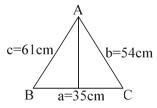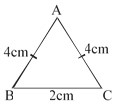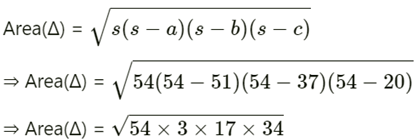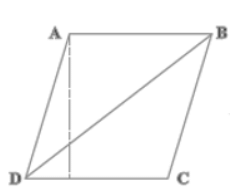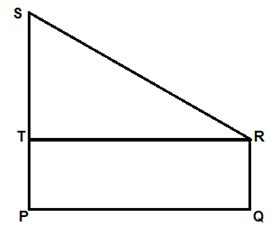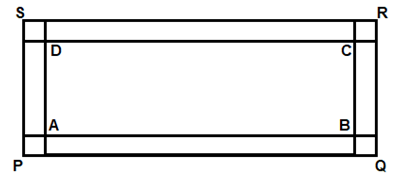NCERT Exemplar Solutions: Heron's Formula | Mathematics (Maths) Class 9 PDF Download
Exercise 12.1
Q.1. An isosceles right triangle has area 8 cm2. The length of its hypotenuse is
(a) √32 cm
(b) √16 cm
(c) √48 cm
(d) √24 cm
The correct answer is Option (a).
Let height of triangle = h
As the triangle is isosceles,
Let base = height = h
According to the question,
Area of triangle = 8cm2
⇒ ½ × Base × Height = 8
⇒ ½ × h × h = 8
⇒ h2 = 16
⇒ h = 4cm
Base = Height = 4cm
Since the triangle is right angled,
Hypotenuse2 = Base2 + Height2
⇒ Hypotenuse2 = 42 + 42
⇒ Hypotenuse2 = 32
⇒ Hypotenuse = √32
Q.2. The perimeter of an equilateral triangle is 60 m. The area is
(a) 10√3 m2
(b) 15√3 m2
(c) 20√3 m2
(d) 100√3 m2
The correct answer is Option (d).
Area of an equilateral triangle of side a = √3/4 a2
According to the question,
Perimeter of triangle = 60m
⇒ a + a + a = 60
⇒ 3a = 60
⇒ a = 20m
Area of the triangle = (√3/4) a2
= (√3/4) (20)2
= (√3/4) (400)
= 100√3 m2
Q.3. The sides of a triangle are 56 cm, 60 cm and 52 cm long. Then the area of the triangle is
(a) 1322 cm2
(b) 1311 cm2
(c) 1344 cm2
(d) 1392 cm2
The correct answer is Option (c).
According to the question,
Sides of a triangle:
a = 56
b = 60
c = 52Calculate the semi-perimeter (s):
s = (a + b + c)/2
⇒ s = (56 + 60 + 52)/2
= 168/2 = 84 cm
Area of the triangle = √s(s - a)(s - b)(s - c)
= √84(84 - 56)(84 - 60)(84 - 52)
= √84 × 28 × 24 × 32
= 1344cm2
Q.4. The area of an equilateral triangle with a side 2√3 cm is
(a) 5.196 cm2
(b) 0.866 cm2
(c) 3.496 cm2
(d) 1.732 cm2
The correct answer is Option (a).
Area of an equilateral triangle of side a = √3/4 a2
According to the question,Side length, a = 2√3 cm
Area of the triangle = (√3/4) a2
= (√3/4) (2√3)2
= (√3/4)(12)
= 3√3
= 5.196 cm2
Q.5. The length of each side of an equilateral triangle having an area of 9√3 cm2 is
(a) 8 cm
(b) 36 cm
(c) 4 cm
(d) 6 cm
The correct answer is Option (d).
Given, area of an equilateral triangle = 9√3 cm2
∴ Area of an equilateral triangle = √3/4(Side)2
=> √3/4 (Side)2 = 9√3
=> (Side)2 = 36
∴ Side = 6 cm [taking positive square root because side is always positive]
Hence, the length of an equilateral triangle is 6 cm.
Q.6. If the area of an equilateral triangle is 16√3 cm2, then the perimeter of the triangle is
(a) 48 cm
(b) 24 cm
(c) 12 cm
(d) 36 cm
The correct answer is Option (b).
Given, the area of an equilateral triangle = 16√3 cm2
Area of an equilateral triangle = √3/4 (side)2
√3/4(Side)2 = 16√3 => (Side)2 = 64
=> Side =8 cm
Perimeter of an equilateral triangle = 3 x Side = 3 x 8 = 24 cm
Hence, the perimeter of an equilateral triangle is 24 cm.
Q.7. The sides of a triangle are 35 cm, 54 cm and 61 cm, respectively. The length of its longest altitude
(a) 16√5 cm
(b) 10√5 cm
(c) 24√5 cm
(d) 28 cm
The correct answer is Option (c).
Given a = 35cm, b = 54cm, c = 61cm
⇒ S = 75cm
Using Heron's formula area of triangle
We know that area ofABC
Q.8. The area of an isosceles triangle having base 2 cm and the length of one of the equal sides 4 cm, is
(a) √15 cm2
(b) 
(c) 2√15 cm2
(d) 4√15 cm2
The correct answer is Option (a).
We know that, semi - perimeter
S = 10/2 = 2 cm
Using Heron’s formula area of ΔABC
= √15 cm2
Hence, the area of the given triangle is √15 cm2.
Q.9. The edges of a triangular board are 6 cm, 8 cm and 10 cm. The cost of painting it at the rate of 9 paise per cm2 is
(a) Rs 2.00
(b) Rs 2.16
(c) Rs 2.48
(d) Rs 3.00
The correct answer is Option (b).
To find the cost of painting, we have to find the area of the triangular board
Let the sides be denoted as, a = 6 cm, b = 8 cm, c = 10 cm
We know that,
Using Heron’s formula, area of triangle
6 x 2 x 2 = 24cm2
Now cost of painting 1cm2 = 9 paise = Rs 9/100 = Rs. 0.09
∴ cost of painting 24cm2 = 24 x 0.09 = 24 x9/100 = Rs 2.16
Hence, cost of painting Rs. 2.16.
Exercise 12.2
Write True or False and justify your answer:
Q.1. The area of a triangle with base 4 cm and height 6 cm is 24 cm2.
False
Area of triangle = ½ × Base × Altitude
= ½ × 4 × 6
= 12cm2
Hence, the statement “the area of a triangle with base 4 cm and height 6 cm is 24 cm2” is false.
Q.2. The area of ∆ ABC is 8 cm2 in which AB = AC = 4 cm and ∠A = 90º.
True
Area of triangle = ½ × Base × Altitude
= ½ × 4 × 4
= 8cm2
Hence, the statement is “area of △ABC is 8 cm2 in which AB = AC = 4 cm and ∠A = 90º” is true.
Q.3. The area of the isosceles triangle is  cm2, if the perimeter is 11 cm and the base is 5 cm.
cm2, if the perimeter is 11 cm and the base is 5 cm.
True
According to the question,
Perimeter = 11cm
And base, a = 5
As the triangle is isosceles, b = c
Perimeter = 11
⇒ a + b + c = 11
⇒ 5 + b + b = 11
⇒ 5 + 2b = 11
⇒ 2b = 6
⇒ b = 3 cm
So, we have,
a = 5, b = 3, c = 3
s = (a + b + c)/2
⇒ s = (5 + 3 + 3)/2 = 11/2
Area of triangle = √s(s-a)(s-b)(s-c)
⇒ Area of triangle = (5√11)/4cm2Hence, the statement “The area of the isosceles triangle is 5/4 √11cm2, if the perimeter is 11 cm and the base is 5 cm” is true.
Q.4. The area of the equilateral triangle is 20√3 cm2 whose each side is 8 cm.
False
Area of an equilateral triangle of side a = √3/4 a2Substituting the given side length:
Area = √3/4 × (8 cm)²
Area = √3/4 × 64 cm²
Area = 16√3 cm²
Hence, the statement “the area of the equilateral triangle is 20√3 cm2 whose each side is 8 cm” is false.
Q.5. If the side of a rhombus is 10 cm and one diagonal is 16 cm, the area of the rhombus is 96 cm2.
True
To find the area of rhombus, we divide it into two triangles.
As all the sides of a rhombus are equal, we have for a triangle
a = 10 cm, b = 10 cm, c = 16 cm
s = (a + b + c)/2
⇒ s = (10 + 10 + 16)/2 = 36/2 = 18 cm
Area(Δ) = √s(s - a)(s - b)(s - c)
⇒ Area(Δ) = √18(18 - 10)(18 - 10)(18 - 16)
⇒ Area(Δ) = √18 × 8 × 8 × 2
⇒ Area(Δ) = 48 cm2
The other triangle's sides are also same, so their areas will also be equal.
Area(Rhombus) = Area(Δ) + Area(Δ)
⇒ Area(Rhombus) = 48 + 48 = 96 cm2
Therefore, the statement is true.
Q.6. The base and the corresponding altitude of a parallelogram are 10 cm and 3.5 cm, respectively. The area of the parallelogram is 30 cm2.
False
We know that
Area of a parallelogram = Base x Altitude = 10 x 3.5
Hence, the area of parallelogram is 35 cm2
Therefore the given statement is false.
Q.7. The area of a regular hexagon of side ‘a’ is the sum of the areas of the five equilateral triangles with side a.
False
According to question
Area of regular hexagon = Sum of area of the five equilateral triangles.
We know that a regular hexagon is divided into 6 equilateral triangles by its diagonals.
Therefore, the given statement is false.
Q.8. The cost of levelling the ground in the form of a triangle having the sides 51 m, 37 m and 20 m at the rate of Rs 3 per m2 is Rs 918.
True
a = 51, b = 37, c = 20
⇒ Area(Δ) = 306 m2
Cost of painting = Area(Δ) × Cost per m2
⇒ Cost of painting = 306 × 3 = Rs. 918
Q.9. In a triangle, the sides are given as 11 cm, 12 cm and 13 cm. The length of the altitude is 10.25 cm corresponding to the side having length 12 cm.
True
a = 11, b = 12, c = 13
s = (a + b + c)/2
⇒ s = (11 + 12 + 13)/2 = 36/2 = 18 cm
Area(Δ) = √s(s - a)(s - b)(s - c)
⇒ Area(Δ) = √18(18 - 11)(18 - 12)(18 - 13)
⇒ Area(Δ) = √18 × 7 × 6 × 5
⇒ Area(Δ) = 6√105 cm2 = 61.48 ∼ 61.5 cm2
Area(Δ) = 1/2 × Base × Altitude
⇒ Area(Δ) = 1/2 × 12 × 10.25
⇒ Area(Δ) = 61.5 cm2
Hence the statement is true.
Exercise 12.3
Q.1. Find the cost of laying grass in a triangular field of sides 50 m, 65 m and 65 m at the rate of Rs 7 per m2.
According to the question,
Sides of the triangular field are 50 m, 65 m and 65 m.
Cost of laying grass in a triangular field = Rs 7 per m2
Let a = 50, b = 65, c = 65
s = (a + b + c)/2
⇒ s = (50 + 65 + 65)/2
= 180/2
= 90 m
Area of triangle = √s(s - a)(s - b)(s - c)
= √90(90 - 50)(90 - 65)(90 - 65)
= √90 × 40 × 25 × 25
= 1500m2
Cost of laying grass = Area of triangle × Cost per m2
= 1500 × 7
= Rs.10500
Q.2. The triangular side walls of a flyover have been used for advertisements. The sides of the walls are 13 m, 14 m and 15 m. The advertisements yield an earning of Rs 2000 per m2 a year. A company hired one of its walls for 6 months. How much rent did it pay?
According to the question,
The sides of the triangle are 13 m, 14 m and 15 mLet a = 13, b = 14, c = 15
s = (a + b + c)/2
⇒ s = (13 + 14 + 15)/2
= 42/2
= 21 m
Area of triangle = √s(s - a)(s - b)(s - c)
= √21(21 - 13)(21 - 14)(21 - 15)
= √21 × 8 × 7 × 6
= 84 m2
Cost of advertisements for a year = Area of triangle × Cost per m2
= 84 × 2000
= Rs. 168000
Since the board is rented for only 6 months:
Cost of advertisements for 6 months = (6/12) × 168000
= Rs. 84000
Q.3. From a point in the interior of an equilateral triangle, perpendiculars are drawn on the three sides. The lengths of the perpendiculars are 14 cm, 10 cm and 6 cm. Find the area of the triangle.
According to the question,
The lengths of the perpendiculars are 14 cm, 10 cm and 6 cm.
We know that,
Area of an equilateral triangle of side a = √3/4 a2
We divide the triangle into three triangles,
Area of triangle = (1/2 × a × 14) + (1/2 × a × 10) + (1/2 × a × 6)
√3/4 a2 = ½ × a × (14 + 10 + 6)
√3/4 a2 = ½ × a × 30
a = 60/√3
= 20√3
Area of the triangle = √3/4 a2
=√3/4 (20√3)2
= 300√3 cm2
Q.4. The perimeter of an isosceles triangle is 32 cm. The ratio of the equal side to its base is 3 : 2. Find the area of the triangle.
According to the question,
Perimeter of the isosceles triangle = 32 cm
It is also given that,
Ratio of equal side to base = 3 : 2
Let the equal side = 3x
So, base = 2x
Perimeter of the triangle = 32
⇒ 3x + 3x + 2x = 32
⇒ 8x = 32
⇒ x = 4
Equal side = 3x = 3×4 = 12
Base = 2x = 2×4 = 8
The sides of the triangle = 12cm, 12cm and 8cm.
Let a = 12, b = 12, c = 8
s = (a + b + c)/2
⇒ s = (12 + 12 + 8)/2
= 32/2
= 16 cm
Area of the triangle = √s(s - a)(s - b)(s - c)
= √16(16 - 12)(16 - 12)(16 - 8)
= √16 × 4 × 4 × 8
= 32√2 cm2
Q.5. Find the area of a parallelogram given in Fig. 12.2. Also find the length of the altitude from vertex A on the side DC.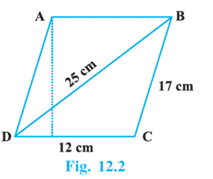
We know that,
Area of parallelogram(ABCD) = Area(ΔBCD) + Area(ΔABD)
For Area (ΔBCD),
We have,
a = 12, b = 17, c = 25
s = (a + b + c)/2
⇒ s = (12 + 17 + 25)/2 = 54/2 = 27.
Area of (ΔBCD) = √s(s - a)(s - b)(s - c)
= √27(27 - 12)(27 - 17)(27 - 25)
= √27 × 15 × 10 × 2
= 90 cm2
Since, ABCD is a parallelogram,
Area(ΔBCD) = Area(ΔABD)
Area of parallelogram(ABCD) = Area(ΔBCD) + Area(ΔABD)
= 90 + 90
= 180 cm2
Let altitude from A be = x
Also, Area of parallelogram(ABCD) = CD × (Altitude from A)
⇒ 180 = 12 × x
⇒ x = 15 cm
Q.6. A field in the form of a parallelogram has sides 60 m and 40 m and one of its diagonals is 80 m long. Find the area of the parallelogram.
For Area(ΔBCD),
a = 60, b = 40, c = 80
s = (a + b + c)/2
⇒ s = (60 + 40 + 80)/2 = 180/2 = 90
Area(ΔBCD) = √s(s - a)(s - b)(s - c)
⇒ Area(ΔBCD) = √90(90 - 60)(90 - 40)(90 - 80)
⇒ Area(ΔBCD) = √90 × 30 × 50 × 10
⇒ Area(ΔBCD) = 300√15 cm2
As ABCD is a parallelogram, Area(ΔBCD) = Area(ΔABD)
⇒ Area of parallelogram(ABCD) = Area(ΔBCD) + Area(ΔABD)
⇒ Area of parallelogram(ABCD) = 300√15 + 300√15
⇒ Area of parallelogram(ABCD) = 600√15 = 2323.79 cm2
Q.7. The perimeter of a triangular field is 420 m and its sides are in the ratio 6 : 7 : 8. Find the area of the triangular field.
Given, the perimeter of the triangular field is 420 m
The sides are in the ratio 6 : 7 : 8
We have to find the area of the triangular field.
Let the sides be
a = 6x
b = 7x
c = 8x
Perimeter = a + b + c
420 = 6x + 7x + 8x
21x = 420 x = 420/21
x = 20
a = 6(20) = 120
b = 7(20) = 140
c = 8(20) = 160
By Heron’s formula,
Area of triangle = √s(s - a)(s - b)(s - c)
Where s = semiperimeter
s = (a + b + c)/2
So, s = (120 + 140 + 160)/2
= 420/2 s
= 210 cm
Area = √210(210 - 120)(210 - 140)(210 - 160)
= √210(90)(70)(50)
= √7 × 3 × 9 × 7 × 5 × 10000
= 100 × 3 × 7 (√3 × 5)
= 2100√15 cm2
Therefore, the area of the triangular field is 2100√15 cm2.
Q.8. The sides of a quadrilateral ABCD are 6 cm, 8 cm, 12 cm and 14 cm (taken in order) respectively, and the angle between the first two sides is a right angle. Find its area.
Given, ABCD is a quadrilateral
The sides of the quadrilateral are 6 cm, 8 cm, 12 cm and 14 cm (taken in order)
The angle between the first two sides is a right angle.
We have to find the area of the quadrilateral.
Given, ABC is a right triangle with B at right angle.
By using Pythagorean theorem,
AC2 = AB2 + BC2
AC2 = (6)2 + (8)2
AC2 = 36 + 64 AC2 = 100
Taking square root,
AC = 10 cm
Area of quadrilateral ABCD = area of triangle ABC + area of triangle ACD
Area of triangle = 1/2 × base × height
Area of triangle ABC = 1/2 × BC × AB
= 1/2 × 8 × 6
= 4 × 6
Area of triangle ABC = 24 cm2
Considering triangle ACD,
a = 10 cm
b = 12 cm
c = 14 cm
By Heron’s formula,
Area of triangle = √s(s - a)(s - b)(s - c)
Where s = semiperimeter
s = (a + b + c)/2
So, s = (10 + 12 + 14)/2
= 36/2
s = 18 cm
Area of triangle ACD = √18(18 - 10)(18 - 12)(18 - 14)
= √18(8)(6)(4)
= √9 × 2 × 4 × 2 × 3 × 2 × 4
= (3 × 2 × 4)√3 × 2
Area of triangle ACD = 24√6 cm2
Area of ABCD = 24 + 24√6
= 24(1 + √6) cm2
Therefore, the area of quadrilateral ABCD is 24(1 + √6) cm2.
Q.9. A rhombus shaped sheet with perimeter 40 cm and one diagonal 12 cm, is painted on both sides at the rate of Rs 5 per m2. Find the cost of painting.
Given, a sheet in the shape of rhombus with perimeter 40 cm
One diagonal is 12 cm
We have to find the cost of painting both the sides at the rate of Rs. 5 per cm2
Let ABCD be a rhombus with each side equal to x cm
AB = BC = CD = AD = x cm
Perimeter of rhombus = 40
AB + BC + CD + AD = 40
x + x + x + x = 40
4x = 40
x = 40/4
x = 10
Therefore, the length of each side of rhombus is 10 cm
In triangle ABC,
AB = BC = 10 cm
AC = 12 cm
Since two sides are equal the triangle is an isosceles triangle.
Area of isosceles triangle = a/4 √4b2 - a2
Where, a = base
b = equal side
Here, a = 12 cm and b = 10 cm
Area = 12/4 √4(10)2 - (12)2
= 3√4(100) - 144
= 3√400 - 144
= 3√256
= 3(16)
Area of triangle ABC = 48 cm2
Area of rhombus = 2 × area of triangle ABC
= 2(48)
Area of rhombus = 96 cm2
Cost of painting 1 m2 = Rs. 5
Cost of painting one sheet = 96 × 5 = Rs. 480
Cost of painting sheet on both sides = 2 × 480 = Rs. 960
Therefore, the cost of painting is Rs. 960.
Q.10. Find the area of the trapezium PQRS with height PQ given in Fig. 12.3
Given, PQRS is a trapezium with height PQ.
We have to find the area of trapezium PQRS.
Draw RT perpendicular to PS
Now, ST = PS - PT
= 12 - 7
ST = 5 m
Also, PT = RQ
Area of trapezium PQRS = area of triangle STR + area of rectangle PQRT
Considering triangle STR,
STR is a right angle with T at right angle.
By using Pythagorean theorem,
SR2 = ST2 + TR2
(13)2 = (5)2 + TR2
169 = 25 + TR2
TR2 = 169 - 25
TR2 = 144
Taking square root,
TR = 12 cm
Area of triangle = 1/2 × base × height
Area of triangle STR = 1/2 × TR × ST
= 1/2 × 12 × 5
= 6 × 5
Area of triangle STR = 30 cm2
Area of rectangle = length × width
Area of rectangle PQRT = PQ × RQ
= 12 × 7
Area of rectangle PQRS = 84 cm2
Now, area of trapezium PORS = 30 + 84 = 114 cm2
Therefore, the area of trapezium is 114 cm2.
Exercise 12.4
Q.1. How much paper of each shade is needed to make a kite given in Fig. 12.4, in which ABCD is a square with diagonal 44 cm 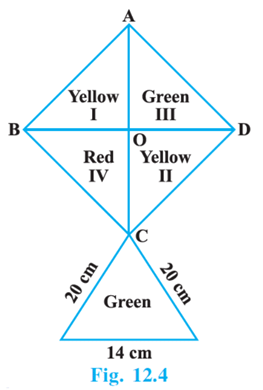
According to the figure,
AC = BD = 44cm
AO = 44/2 = 22cm
BO = 44/2 = 22cm
From ΔAOB,
AB2 = AO2 + BO2
⇒ AB2 = 222 + 222
⇒ AB2 = 2 × 222
⇒ AB = 22√ 2 cm
Area of square = (Side)2
= (22√2)2
= 968 cm2
Area of each triangle (I, II, III, IV) = Area of square /4
= 968 /4
= 242 cm2
To find area of lower triangle,
Let a = 28, b = 28, c = 14
s = (a + b + c)/2
⇒ s = (28 + 28 + 14)/2 = 70/2 = 35.
Area of the triangle = √s(s - a)(s - b)(s - c)
= √35(35 - 28)(35 - 28)(35 - 14)
= √35 × 7 × 7 × 21
= 49√15 = 189.77cm2
Therefore,
We get,
Area of Red = Area of IV
= 242 cm2
Area of Yellow = Area of I + Area of II
= 242 + 242
= 484 cm2
Area of Green = Area of III + Area of lower triangle
= 242 + 189.77
= 431.77 cm2
Q.2. . The perimeter of a triangle is 50 cm. One side of a triangle is 4 cm longer than the smaller side and the third side is 6 cm less than twice the smaller side. Find the area of the triangle.
Let the smaller side be = x cm
Then, larger side = (x + 4) cm
And, third side = (2x-6) cm
Given that,
Perimeter = 50 cm
⇒ x + (x + 4) + (2x-6) = 50
⇒ 4x - 2 = 50
⇒ 4x = 52
⇒ x = 13
Therefore, smaller side = 13cm
Larger side = x + 4 = 13 + 4 = 17cm
Third side = 2 x -6 = 2 × 13 – 6 = 26 - 6 = 20 cm
To find area of triangle,
Let a = 13, b = 17, c = 20
s = (a + b + c)/2
⇒ s = (13 + 17 + 20)/2 = 50/2 = 25 cm
Area of triangle = √s(s - a)(s - b)(s - c)
= √25(25 - 13)(25 - 17)(25 - 20)
= √25 × 12 × 8 × 5
= 20√30 cm2
Q.3. The area of a trapezium is 475 cm2 and the height is 19 cm. Find the lengths of its two parallel sides if one side is 4 cm greater than the other.
Let the given trapezium be PQRS, given in the figure.
According to the question,
PQ = 19cm
Let RQ = x cm
Then,
PS = (x + 4)cm
Construction:
Draw a perpendicular from R on PS which will also be parallel to PQ.
Now,
We get,
PQRT is a rectangle,
Area of rectangle PQRT = PQ × QR
⇒ Area(PQRT) = 19×x = 19x
Now,
PS = PT + TS
Since PT = QR = x cm
(x + 4) = x + TS
⇒ TS = 4cm
Area of triangle RST = ½ × RT × ST
Since RT = PQ = 19cm
⇒ Area(ΔRST) = ½ × 19 × 4
= 38cm2
Area(PQRS) = Area(PQRT) + Area(ΔRST)
⇒ 475 = 19x + 38
⇒ 19x = 475 -38
⇒ 19x = 437
⇒ x = 23 cm
(x + 4) = 23 + 4 = 27 cm
Therefore, the lengths of parallel sides are 23 cm and 27 cm.
Q.4. A rectangular plot is given for constructing a house, having a measurement of 40 m long and 15 m in the front. According to the laws, a minimum of 3 m, wide space should be left in the front and back each and 2 m wide space on each of other sides. Find the largest area where house can be constructed.
Let the given rectangle be rectangle PQRS,
According to the question,
PQ = 40m and QR = 15m
As 3m is left in both front and back,
AB = PQ -3 -3
⇒ AB = 40 -6
⇒ AB = 34m
Also,
Given that 2m has to be left at both the sides,
BC = QR - 2 – 2
⇒ BC = 15 - 4
⇒ BC = 11m
Now, Area left for house construction is area of ABCD.
Hence,
Area(ABCD) = AB × CD
= 34 × 11
= 374 m2
Q.5. A field is in the shape of a trapezium having parallel sides 90 m and 30 m. These sides meet the third side at right angles. The length of the fourth side is 100 m. If it costs Rs 4 to plough 1m2 of the field, find the total cost of ploughing the field.
Given, the field is in the shape of a trapezium
The parallel sides are 90 m and 30 m
The parallel sides meet the third side at right angles
The length of the fourth side is 100 m
We have to find the cost of ploughing the entire field at the rate of Rs. 4/m²
Consider a trapezium ABCD
Draw CE perpendicular to AB
DC = AE = 30 m
EB = AB - AE
EB = 90 - 30
EB = 60 m
Consider right angled triangle BEC,
By using Pythagorean theorem,
BC2 = BE2 + EC2
(100)2 = (60)2 + EC2
EC2 = 10000 - 3600
EC2 = 6400
Taking square root, EC = 80 m
Area of trapezium = 1/2 × sum of parallel sides × distance between parallel sides
Area of trapezium ABCD = 1/2 × (AB + CD) × EC
= 1/2 × (90 + 30) × 80
= 1/2 × 120 × 80
= 60 × 80
= 4800 m2
Cost of ploughing 1 m2 of field = Rs. 4
Cost of ploughing 4800 m2 of field = 4800 × 4
= Rs. 19200
Therefore, the cost of ploughing the field is Rs. 19200.
Q.6. . In Fig. 12.5, ∆ ABC has sides AB = 7.5 cm, AC = 6.5 cm and BC = 7 cm. On base BC a parallelogram DBCE of the same area as that of ∆ ABC is constructed. Find the height DF of the parallelogram.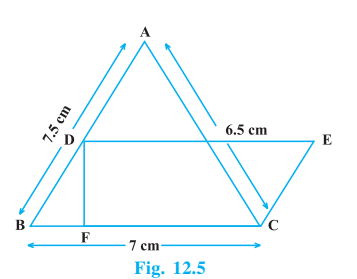
a = 6.5, b = 7, c = 7.5
s = (a + b + c)/2
⇒ s = (6.5 + 7 + 7.5)/2 = 21/2 = 10.5
Area(Δ) = √s(s - a)(s - b)(s - c)
⇒ Area(Δ) = √10.5(10.5 - 6.5)(10.5 - 7)(10.5 - 7.5)
⇒ Area(Δ) = √10.5 × 4 × 3.5 × 3
⇒ Area(Δ) = 21 cm2
Area of parallelogram (BCED) = Area (Δ)
⇒ BC × DF = 21
⇒ 7 × DF = 21
⇒ DF = 3 cm
Q.7. The dimensions of a rectangle ABCD are 51 cm × 25 cm. A trapezium PQCD with its parallel sides QC and PD in the ratio 9 : 8, is cut off from the rectangle as shown in the Fig. 12.6. If the area of the trapezium PQCD is 5/6th part of the area of the rectangle, find the lengths QC and PD.
Area of rectangle (ABCD) = BC × CD
⇒ Area of rectangle (ABCD) = 51 × 25 = 1275 cm2
Area of trapezium PQCD = 5/6 × Area of rectangle (ABCD)
⇒ Area of trapezium PQCD = 5/6 × 1275 = 1062.5 cm2
Given that QC : PD = 9 : 8
Let QC = 9x and PD = 8x
Area (PQCD) = (Sum of parallel sides)/2 x Height
⇒ Area (PQCD) = (9x + 8x)/2 x 25
⇒ 1062.5 = (17x)/2 x 25
⇒ 85 = 17x
⇒ x = 5 cm
QC = 9x = 45 cm
PD = 8x = 40 cm
Q.8. A design is made on a rectangular tile of dimensions 50 cm × 70 cm as shown in Fig. 12.7. The design shows 8 triangles, each of sides 26 cm, 17 cm and 25 cm. Find the total area of the design and the remaining area of the tile.
Given, a design is made on a rectangular tile of dimension 50 cm × 70 cm
The design shows 8 triangles with dimensions 26 cm, 17 cm and 25 cm
We have to find the total area of the design and the remaining area of the tile.
Area of rectangle = length × breadth
Area of rectangular tile = 50 × 70 = 3500 cm2
Consider one triangle out of 8 triangles,
By Heron’s formula,
Area of triangle = √s(s - a)(s - b)(s - c)
Where s = semiperimeter s = (a + b + c)/2
Here, a = 26 cm, b = 17 cm and c = 25 cm
So, s = (26 + 17 + 25)/2
= 68/2
s = 34 cm
Area = √34(34 - 26)(34 - 17)(34 - 25)
= √34(8)(17)(9)
= √17 × 2 × 2 × 4 × 17 × 9
= 17 × 2 × 2 × 3
Area of one triangle = 204 cm2
Area of 8 triangles = 8(204) = 1632 cm2
Therefore, total area of the design is 1632 cm2
Remaining area of the tile = area of rectangular tile - area of 8 triangles
= 3500 - 1632
= 1868 cm2
Therefore, the remaining area of the tiles is 1868 cm2.
|
40 videos|471 docs|57 tests
|
FAQs on NCERT Exemplar Solutions: Heron's Formula - Mathematics (Maths) Class 9
| 1. What is Heron's Formula and how is it derived? |  |
| 2. How do you use Heron's Formula to find the area of a triangle with given side lengths? |  |
| 3. Can Heron's Formula be used for any type of triangle? |  |
| 4. What are some real-life applications of Heron's Formula? |  |
| 5. How can I verify my calculations when using Heron's Formula? |  |

